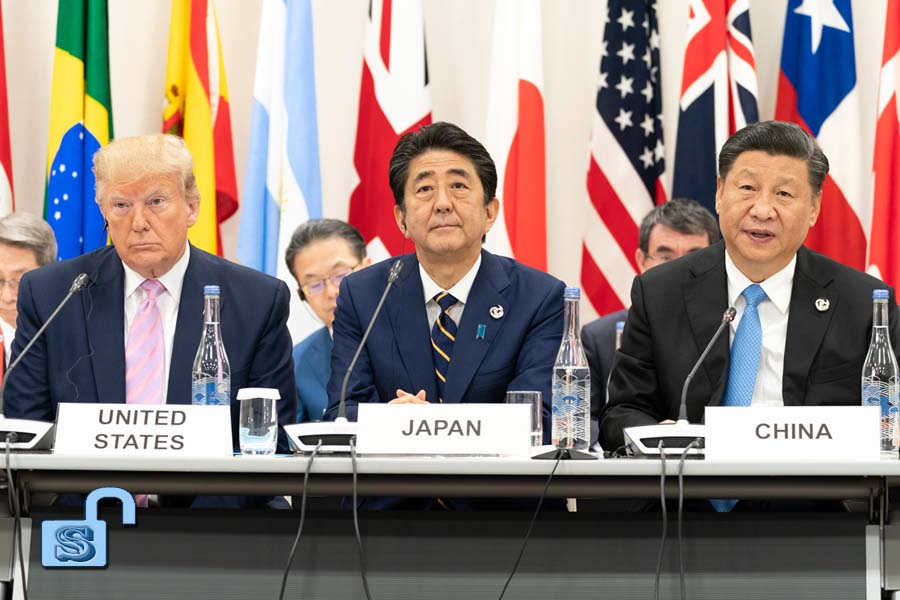◎ Unless Xi resolves factional politics at home, China and the U.S. will find it very hard to get a trade deal.
After meeting with Chinese leader Xi Jinping at the G20 summit in Osaka, United States President Donald Trump announced that both sides agreed to resume trade negotiations.
For Xi, getting the trade talks restarted might be the sole “victory” from his discussions with Trump:
- While Trump said that he would not be adding on to existing tariffs on China, this was only “at least for the time being”;
- Trump said that he would allow U.S. companies to sell equipment to Huawei, but “where there is no great national emergency problem with it.” In an interview with Fox News on June 30, White House economic advisor Larry Kudlow said that Huawei would remain on the U.S. entity list and that the U.S. Commerce Department may grant “some temporary additional licenses” to U.S. companies to allow them to sell to Huawei. “This is not a general amnesty,” he said;
- Trump said that he and Xi did not discuss the fate of detained Huawei CFO Meng Wanzhou;
- Trump said that he and Xi agreed to leave “Huawei toward the end” of the trade discussions;
- Trump said that “China is going to be buying a tremendous amount of food and agricultural product” from the United States. On June 28, China purchased 544,000 tonnes of American soybeans worth nearly $200 million.
- According to the Chinese government’s white paper on Sino-U.S. trade talks published on June 2, “one prerequisite for a trade deal is that the U.S. should remove all additional tariffs imposed on Chinese exports and China’s purchase of U.S. goods should be realistic while ensuring that a proper balance in the text of the agreement is achieved to serve the common interests of both sides.” While the final deal might address the issues raised in the white paper, Xi and Trump have agreed to continue trade negotiations despite the U.S. not removing additional tariffs, China committing to make “tremendous amount of food and agricultural product” purchases from the U.S., and with the Trump administration not backing down from its demand that China completely opens its markets and makes other regime-threatening structural reforms.
During the period in which trade talks were suspended (early May to late June), the Chinese regime also sustained serious losses:
- On May 10, U.S. tariff rates on $200 billion worth of Chinese goods were increased from 10 percent to 25 percent;
- On May 15, Huawei and its 70 foreign subsidiaries and affiliates were added to the U.S. entity list;
- On June 21, five Chinese supercomputing organizations were placed on the U.S. entity list;
- China’s stock markets plummeted. From the last trading day before Trump threatened to imposed additional tariffs on all Chinese exports (April 30) to the trading day when he and Xi spoke on the phone (June 18), the Shanghai and Shenzhen stock exchanges evaporated a total of 3.7 trillion yuan ($538.831 billion). In the same period, the Shanghai exchange was down 6.51 percent while the Shenzhen exchange was down 9.88 percent;
Foreign capital, companies, and supply chains continued to pull out of China. In particular, big retail companies Carrefour and Takashimaya announced that were exiting the mainland in the last week of June.
It is clear from the above that Xi Jinping emerged a big loser from the Trump-Xi G20 summit.
Our take:
1. The outcome of the Trump-Xi summit is in line with our G20 Early Brief analysis: “An optimistic outcome of the Trump-Xi G20 meeting would see both sides agree to keep communication channels open and restart the trade talks. Trump could give Xi a short reprieve to solve his domestic politics and ensure successful trade negotiations. To that end, Trump could either add $300 billion in tariffs at a 10 percent rate or even suspend the tariffs until further notice.” (For the duration of tariff reprieve and explanation of Xi’s domestic politics, please order the full report.)
2. President Trump could have refrained from imposing further tariffs on China in considering the negative impact that the tariffs would have on the U.S. economy and financial markets before the 2020 U.S. presidential election. Also, the Trump administration might not yet be ready to deal with the fallout of applying maximum pressure on the Chinese regime (see our June 19 analysis).
3. We previously observed the hardening of Chinese regime rhetoric towards the U.S. after Trump’s May 5 announcement of additional tariffs. We believe that the tough messaging in propaganda can be partially attributed to the CCP factional struggle; Xi’s political enemies and Party “hardliners” do not want him to successfully negotiate a trade deal with America. The factional struggle explains the odd messaging in a June 26 commentary on Xinhua, which cautions those who would “lob hand grenades backward,” or “surrender” and “show weakness” to America in the trade war where “both armies are locked in a face-off” (两军对垒).
The CCP factional struggle will likely escalate in light of Xi’s poor showing at the G20 summit. We believe that Xi’s political risks will increase exponentially in the coming weeks and months of 2019.
Xi’s political opponents have set impossible terms and conditions for him to reach a trade agreement with the United States. Unless Xi resolves factional politics at home, China and the U.S. will find it very hard to get a trade deal.
4. Factional politics aside, it is in the Chinese Communist Party’s interest to extend trade negotiations. The U.S., however, may not fall easily for CCP delaying tactics this time.
What’s next:
1. Xi Jinping will need to carry out another round of purges if he wishes to sign a trade deal agreement that is acceptable to the U.S. and avoid regime-crippling sanctions (at least for a good period of time). The purges may touch current and retired members of the Politburo and its Standing Committee.
2. We believe that President Trump would impose additional tariffs on China in the second half of 2019 as we predicted in our China outlook for the year. Also, the U.S. could continue to shut out Huawei and other Chinese technology companies, as well as move to pressure the Chinese regime on the Hong Kong issue and on human rights.
Get smart:
Developments in Sino-U.S. relations are unfolding as per our predictions in our special report, “2019: A Waterloo Year for China and the United States.” The report also contains our analysis of who might emerge victorious in a China-U.S. “Battle of Waterloo,” which we believe will take place in the second half of 2019.
The U.S. has a prime window of opportunity to fundamentally resolve Sino-U.S. problems while Xi Jinping is in office. The U.S. can take advantage of this window of opportunity by applying greater pressure on the Chinese regime and targeted pressure against specific Party factions. The U.S. also needs novel solutions to sidestep the “clash of civilizations” issue.

 [wpdreams_rpp id=0]
[wpdreams_rpp id=0]










